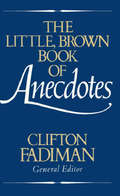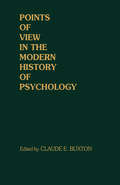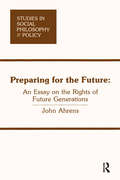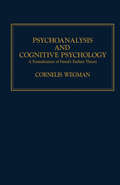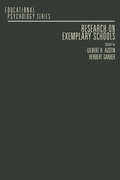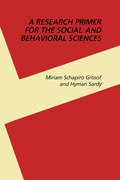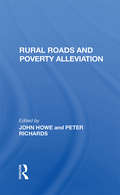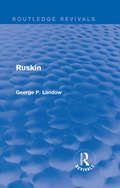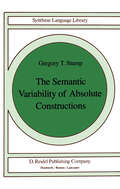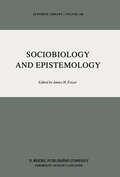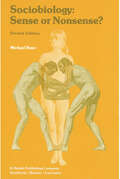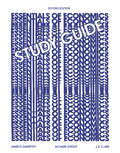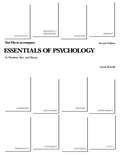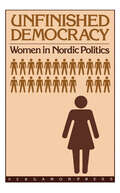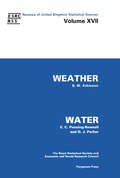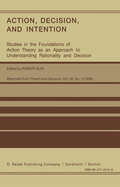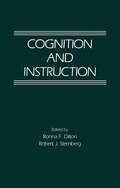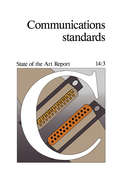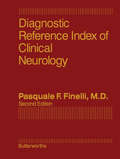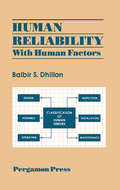- Table View
- List View
The Little, Brown Book of Anecdotes
by Clifton FadimanA book compiled of anecdotes from other collections, arranged under the name of the person they're about.
The Little, Brown Book of Anecdotes
by Clifton FadimanA book compiled of anecdotes from other collections, arranged under the name of the person they're about.
Moon Normandy & Brittany: With Mont-Saint-Michel (Travel Guide)
by Chris NewensDramatic coastline, charming villages, unforgettable history, and distinct local culture: See a different side of France with Moon Normandy & BrittanyFlexible itineraries for 1 to 5 days in Normandy and Brittany that can be combined into a 2-week trip, plus suggestions for easy side tripsStrategic advice for foodies, art lovers, history buffs, outdoor adventurers, and moreMust-see highlights and unique experiences: Hike the dramatic chalk cliffs of Étretat or stroll the gardens that inspired Monet's Water Lilies. Cycle the rolling hills and endless backroads to small villages and sip cider with locals at a Celtic Festoù-noz pulsing with traditional dance and music. Pay your respects at the D-Day beaches and monuments and learn about the largest military landing in history. Admire the spectacular monastery rising above the tidal plains of Mont Saint Michel and enjoy fresh seafood in Saint-MaloHonest advice on where to stay, how to get around, and where to find the best regional cuisine, from creamy cheeses in Normandy to Breton galettes and ciderLocal perspective from British expat and local expert Chris NewensFull-color photos and detailed maps throughoutBackground information on the landscape, history, and cultural customs of each regionHandy tools such as a French phrasebook and tips for traveling with children or as a seniorWith Moon Normandy & Brittany's practical tips and local insight on the best things to do and see, you can plan your trip your way.Exploring more of France? Try Moon Paris Walks. Craving the beach? Check out Moon Amalfi Coast.
Points of View in the Modern History of Psychology
by Claude E. BuxtonPoints of View in the Modern History of Psychology is a collection of papers that presents each individual contributor's expert knowledge of history in the field of psychology. One paper examines Wilhelm Wundt's concept of psychology as the propaedeutic science surviving and inspiring a generation or more of psychologists. Another paper discusses the early sources and the basic conceptions of functionalism as used in America. John B. Watson proclaims behaviorism as a new discipline in psychology with defining features, such as an objective, deterministic, scientific, and experimental method that can be used in both human and animal studies. Lieberman (1979), Mackenzie (1977) Miller, Galanter, and Pribram (1960) oppose behaviorism on the grounds that it slights the purpose of psychology, and focuses more on methodology to the detriment of theory. One paper notes that the acceptance or influence that a point of view has is based in some ways on the range and clarity of its connections with experimental and observational reality. This collection can prove useful for psychologists, behavioral scientists, psychiatrists, psycho-analysts, students of psychology, philosophy or general history who are interested in the many viewpoints of psychology.
Preparing for the Future: An Essay on the Rights of Future Generations
by John AhrensDoes the present generation have a moral obligation to conserve resources for future generations? Must we accept drastic reductions in our standard of living, and give up the ideals of individual liberty and technological progress in order to preserve the environment? PREPARING FOR THE FUTURE offers an unfashionably optimistic answer to these questions: that future generations cannot have a right to a share of existing resources, because only living persons can have rights. Rejecting the sacrifices that most traditional ethical principles would require of us, it advocates, instead, that members of the present generation may legitimately use all of the resources at their disposal to realize their own values.
Preparing for the Future: An Essay on the Rights of Future Generations
by John AhrensDoes the present generation have a moral obligation to conserve resources for future generations? Must we accept drastic reductions in our standard of living, and give up the ideals of individual liberty and technological progress in order to preserve the environment? PREPARING FOR THE FUTURE offers an unfashionably optimistic answer to these questions: that future generations cannot have a right to a share of existing resources, because only living persons can have rights. Rejecting the sacrifices that most traditional ethical principles would require of us, it advocates, instead, that members of the present generation may legitimately use all of the resources at their disposal to realize their own values.
Psychoanalysis and Cognitive Psychology: A Formalization of Freud's Earliest Theory
by Cornelis WegmanPsychoanalysis and Cognitive Psychology: A Formalization of Freud's Earliest Theory is an attempt to translate psychoanalytic theory into a computer model—a model psychoanalysts will accept as accurately mirroring Freud's theory, while at the same time satisfying the demands made upon any formal model within contemporary psychology. Given the vast extent and the continued development of psychoanalytic theory, the present study focuses on Freud's earliest theory. In a sense, this limitation is a natural one. Anyone really wishing to come to grips with psychoanalytic theory will listen to Freud's advice and follow the path he himself took. In his earliest theory, the theory of abreaction, Freud lays the foundation for all of his later work. Here, for the first time, we encounter concepts—psychical conflict, repression, unconscious ideas, the principle of constancy—which have proved decisive for the development of psychoanalytic theory. Moreover, this was the period during which Freud himself was obsessed by the idea of representing his theory in a single, coherent model, much as in natural science. The present monograph may be regarded as a belated effort to realize the ideal that Freud had in mind in his Project for a Scientific Psychology: a psychology in which psychical processes are represented in such a manner that they become ""perspicuous and free from contradiction"".
Research on Exemplary Schools
by Gilbert R. Austin Herbert GarberResearch on Exemplary Schools covers significant research works on effective school learning, with particular emphasis on identifying and analyzing a student's abilities and characteristics on the assumption that student learning was primarily determined by differences in individual potential and needs. The information provided is derived from the assumption that the characteristics of the school learning environment may explain the extent to which students master the outcomes desired from the school teaching-learning experience.This text is organized into three parts encompassing 10 chapters. Part I reviews the history of the exemplary schools research movements and the research findings, as well as policy implications concerning the relationships between private and public schools education, both Catholic and nonsectarian. Part II describes the methods for identifying exemplary schools, school climate, and the roles of the teacher and the school principal. Part III describes the policy issues emerging from effective schools research. This part also provide some critical thoughts on the movement from the perspective of an educational psychologist whose specialties are educational measurement and instructional design. This book will prove useful to researchers and practitioners who wish to improve the outcomes of all students in their schools.
A Research Primer for the Social and Behavioral Sciences
by Miriam Schapiro Grosof Hyman SardyA Research Primer for the Social and Behavioral Sciences provides an introductory but comprehensive overview of the research process that primarily concerns human subjects.This book discusses the methods of acquiring knowledge, importance of a well-chosen problem, review of the literature, and relationship between theory-building and hypothesis-testing. The common sources of invalidity in practice, non-experimental research types, Stevens' classification of scales, and estimation based on probabilistic sampling are also elaborated. This text likewise covers the role of computer in research, techniques for analysis of data, univariate and bivariate statistics, and assumptions underlying analysis of variance. Other topics include the canonical correlation analysis, non-parametric analysis of variance, deterministic problem analysis techniques, and common errors in presentation of findings.This publication is intended for novice investigators in the broad category of social and behavioral sciences.
Rural Roads And Poverty Alleviation (Rural Building Course Ser. #2)
by John Howe Peter Richards J D HoweThis book analyses the use of rural road networks and the causes and effects of road programmes in the areas of personal travel, education, health and poverty alleviation. It discusses the criteria which are being used for rural road selection and their impact in Egypt, India, Botswana and Thailand.
Rural Roads And Poverty Alleviation
by John Howe Peter Richards J D HoweThis book analyses the use of rural road networks and the causes and effects of road programmes in the areas of personal travel, education, health and poverty alleviation. It discusses the criteria which are being used for rural road selection and their impact in Egypt, India, Botswana and Thailand.
Ruskin: Carlyle, Ruskin, Arnold, Morris (Routledge Revivals)
by George P. LandowRuskin, the great Victorian critics of art and society, had an enormous influence on his age and our own. A highly successful propagandist for the arts, he did much both to popularize high art and to bring it to the masses. A brilliant theorist and practical critics of realism, he also produced the finest nineteenth-century discussions of fantasy, the grotesque, and pictorial symbolism. Most who have written about this outstanding Victorian polymath have approached him either as literary critics or as art historians. In this book, which was first published in 1985, George P. Landow provides a more balanced view and offers a strikingly new approach which reveals that Ruskin wrote throughout his career as an interpreter, an exegete. His interpretations covered many fields of human experience and endeavour, not only paintings, poems, and buildings but also contemporary social issues, such as the discontent of the working classes.
Ruskin (Routledge Revivals)
by George P. LandowRuskin, the great Victorian critics of art and society, had an enormous influence on his age and our own. A highly successful propagandist for the arts, he did much both to popularize high art and to bring it to the masses. A brilliant theorist and practical critics of realism, he also produced the finest nineteenth-century discussions of fantasy, the grotesque, and pictorial symbolism. Most who have written about this outstanding Victorian polymath have approached him either as literary critics or as art historians. In this book, which was first published in 1985, George P. Landow provides a more balanced view and offers a strikingly new approach which reveals that Ruskin wrote throughout his career as an interpreter, an exegete. His interpretations covered many fields of human experience and endeavour, not only paintings, poems, and buildings but also contemporary social issues, such as the discontent of the working classes.
The Semantic Variability of Absolute Constructions (Studies in Linguistics and Philosophy #25)
by G.T. StumpThe goal of this book is to investigate the semantics of absolute constructions in English; specifically, my object is to provide an explanation for the semantic variability of such constructions. As has been widely noted in traditional grammatical studies of English, free adjuncts and absolute phrases have the ability to playa number of specific logical roles in the sentences in which they appear; yet, paradoxically, they lack any overt indication of their logical connection to the clause which they modify. How, then, is the logical function of an absolute construction determined? In attempting to answer this question, one must inevitably address a number of more general issues: Is the meaning assigned to a linguistic expression necessarily determined by linguistic rules, or can the grammar of a language in some cases simply underdetermine the interpretation of expressions? Are the truthconditions of a sentence ever sensitive to the inferences of language users? If so, then is it possible to maintain the validity of any really substantive version of the Compositionality Principle? These are, of course, issues of great inherent interest to anyone concerned with the formal syntax and semantics of natural language, with the philosophy of language, or with language processing. The descriptive framework assumed throughout is the semantic theory developed by Richard Montague (1970a, 1970b, 1973) and his followers. (For a very thorough introduction to Montague semantics, the reader may refer to Dowty, Wall and Peters (1981 ).
Sociobiology and Epistemology (Synthese Library #180)
by James H. FetzerThe papers presented in this special collection focus upon conceptual, the oretical and epistemological aspects of sociobiology, an emerging discipline that deals with the extent to which genetic factors influence or control patterns of behavior as well as the extent to which patterns of behavior, in turn, influence or control genetic evolution. The Prologue advances a compre hensive acco/unt of the field of gene-culture co-evolution, where Lumsden and Gushurst differentiate between "classical" sociobiology (represented especially by Wilson's early work) and current research on human socio biology (represented by Lumsden and Wilson's later work), which emphasizes interplay between genes, minds, and culture. The specter of genetic deter minism, no doubt, has created considerable controversy, some of which may be laid to rest by Hanna's analysis of the (ambiguous) notion of a "genetic program", which indicates the necessity for distinguishing between descriptive and prescriptive dimensions of this complex concept. Brandon offers a framework for assessing the respective contributions of nature and of nurture by advancing a means for measuring genetic and cultural influences upon "inheritance", which supports the conclusion that evolving patterns of behavior do not always maximize inclusive fitness, contrary to what socio biologists have claimed. The influence of culture upon genetic evolution, of course, can be adequately appraised only when a suitable account of culture itself has been found, a desideratum Smillie attempts to satisfy by utilizing the notion of "cinfo" as culturally transmitted ecological informa tion, a resource other species tend not to exploit.
Sociobiology: Sense or Nonsense? (Episteme #8)
by M. RuseIn June 1975, the distinguished Harvard entomologist Edward O. Wilson published a truly huge book entitled, Sociobiology: The New Synthesis. In this book, drawing on both fact and theory, Wilson tried to present a com prehensive overview of the rapidly growing subject of 'sociobiology', the study of the biological nature and foundations of animal behaviour, more precisely animal social behaviour. Although, as the title rather implies, Wilson was more surveying and synthesising than developing new material, he com pensated by giving the most thorough and inclusive treatment possible, beginning in the animal world with the most simple of forms, and progressing via insects, lower invertebrates, mammals and primates, right up to and in cluding our own species, Homo sapiens. Initial reaction to the book was very favourable, but before the year was out it came under withering attack from a group of radical scientists in the Boston area, who styled themselves 'The Science for the People Sociobiology Study Group'. Criticism, of course, is what every academic gets (and needs!); but, for two reasons, this attack was particularly unpleasant. First, not only were Wilson's ideas attacked, but he himself was smeared by being linked with the most reactionary of political thinkers, including the Nazis.
Study Guide to Accompany Gwartney, Stroup, and Clark's Essentials of Economics
by J.R. ClarkStudy Guide to Accompany Gwartney, Stroup, and Clark's Essentials of Economics, Second Edition provides additional features which can be used as reference for students who are using the textbook "Essentials of Economics, Second Edition." The book sections contain self-tests and challenge questions which are so designed that the student who can answer the self-test questions will consistently be able to answer those found in the "Instructor's Manual and Test Bank." The text encourages the student to follow four steps to get the most out of the study guide. The student should follow these steps: (1) Actively participate in the learning process; (2) Seek out prompt, accurate feedback regarding what the student has learned; (3) Learn the relevance of the concepts; and (4) Learn to address economic issues and policies critically. The book covers question topics, such as supply, demand, market process, public sector, aggregate demand, and equilibrium in a simple Keynesian model. The book also deals with questions and problems on skill acquisition, job market, and gains from international trade. The text will be a valuable aid to many students of economics whether they are economics majors are just taking the subject as a requirement in another course. Professors and lecturers of economics and business courses will also benefit from it.
Test File to Accompany Essentials of Psychology
by Sarah RundleTest File to Accompany Essentials of Psychology
Unfinished Democracy: Women in Nordic Politics
by E. Haavio-Mannila T. SkardThis book contains a thorough and detailed comparison of the five Nordic political systems, including the role played by women. It is based on empirical data for the last hundred years which is interpreted with regard to political and social science theories. The results of this study show that the political participation by women has increased rapidly, especially during the last fifteen years.
Weather & Water (Reviews of UK Statistical Sources (RUKSS))
by B.W. Atkinson E.C. Penning-Rowsell D.J. ParkerThis volume reviews statistical information held in a variety of sources in the UK dealing with weather and water. In view of the influence of weather and water supplies on industry and environmental quality, this text will be of particular interest to researchers in these fields.
Action, Decision, and Intention: Studies in the Foundation of Action Theory as an Approach to Understanding Rationality and Decision
by RobertAudiMost of the papers in this collection are contributions to action theory intended to be of some relevance to one or another concern of decision theory, particularly to its application to concrete human behavior. Some of the papers touch only indirectly on problems of interest to decision theorists, but taken together they should be of use to both decision theorists and philosophers of action. Robert Audi's paper indicates how a number of questions in action theory might bear on problems in decision theory, and it suggests how some action-theoretic results may help in the construction or interpretation of theories of decision, both normative and empirical. Carl Ginet's essay lays foundations for the conception of action. His volitional framework roots actions internally and conceives them as irreducibly connected with intentionality. Hugh McCann's essay is also foundational, but stresses intention more than volition and lays some of the groundwork for assessing the rationality of intention and intentional action. In William Alston's paper, the notion of a plan as underlying (intentional) action is central, and we are given both a con ception of the structure of intentional action and a set of implicit goals and beliefs - those whose content is represented in the plan - which form an indispensable part of the basis on which the rationality of the action is to be judged.
Cognition and Instruction
by Ronna F. Dillon Robert J. SternbergCognition and Instruction focuses on the relationship of knowledge acquisition processes with instruction, including reading, writing, mathematics, curriculum design and reform, and reasoning. The selection first takes a look at the issues in cognitive psychology and instruction, reading, and writing. Discussions focus on the processes of knowledge acquisition, cognitive prescriptions for teaching, cognitive components of reading, instruction in reading, distinctive nature of higher order mental activity in written composition, and knowledge-transforming procedures within the general context of higher order skills. The publication also offers information on second language and mathematics. The text ponders on science, social studies, and art. Topics include psychological research related to curriculum design, science curriculum reform, curriculum and instructional components of social studies and social sciences, evidence for individual styles in young children, educational considerations, and concept of style. The text then examines music and reasoning. The selection is a valuable source of data for readers and cognitive psychologists pursuing research on the relationship of cognition and instruction. The most recent developments in cognitive psychologyUp-to-date literature reviewsChapter on training reasoningActive, renowned contributing authors
Communications Standards: State of the Art Report 14:3
by A. V. StokesCommunications Standards deals with the standardization of computer communication networks. This book examines the types of local area networks (LANs) that have been developed and looks at some of the relevant protocols in more detail. The work of Project 802 is briefly discussed, along with a protocol which has developed from one of the LAN standards and is now a de facto standard in one particular area, namely the Manufacturing Automation Protocol (MAP). Factors that affect the usage of networks, such as network management and security, are also considered. This book is divided into three sections and begins with an overview of various aspects of communications standards, paying particular attention to the ISO Open Systems Interconnection (OSI) Network Layer. Conformance testing of protocols and the use of computers in the manufacturing industry are considered. The following chapters focus on the OSI Data Link Layer, Physical Layer, and Session Layer; management issues in OSI; the ISO File Transfer, Access and Management (FTAM) protocol; and the different environments in which OSI and IBM's Systems Network Architecture (SNA) are defined. Message-handling protocols, the CCITT Recommendation X.25, and high-level protocols on Ethernet are also described. This monograph will be of interest to professionals in the field of computer science.
Diagnostic Reference Index of Clinical Neurology
by Pasquale F. FinelliDiagnostic Reference Index of Clinical Neurology aims to give the busy clinician a fast, easy-to-use guide to the core neurological literature published from 1980 to 1986. This book is divided into two sections, key words and references. The keywords section consists of neuroscience terms and each main entry is followed by reference citation numbers and corresponding references. This index, unlike the usual computerized systems for literature retrieval, is structured around clinical problems and uses the approach and terminology of a practicing neurologist. The contents were sources from the full text of articles that were published in critical core of fourteen major international English-language journals in medicine and neurology. This book will be of interest to neurology students and to practicing clinical neurologists.
Human Reliability: With Human Factors
by Balbir S. DhillonHuman Reliability: With Human Factors focuses on human reliability during system design. The book is organized into 13 chapters, wherein Chapter 1 presents histories of human factors and human reliability along with selective terms and definitions. Chapter 2 shows basic reliability mathematics and concepts. Subsequent chapters then elaborate on human reliability, human errors, six human reliability analysis methods, and reliability evaluation of systems with human errors. Other chapters elucidate human factors in maintenance and maintainability; human safety; human reliability data; and human factors in quality control, design, mathematical models, and formulas. Applications of human factors engineering are also addressed. The text will be valuable to human factor engineers and specialists, reliability and maintainability specialists, system and design engineers, industrial engineers, quality control engineers, and students.
